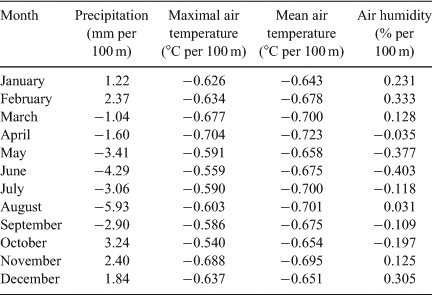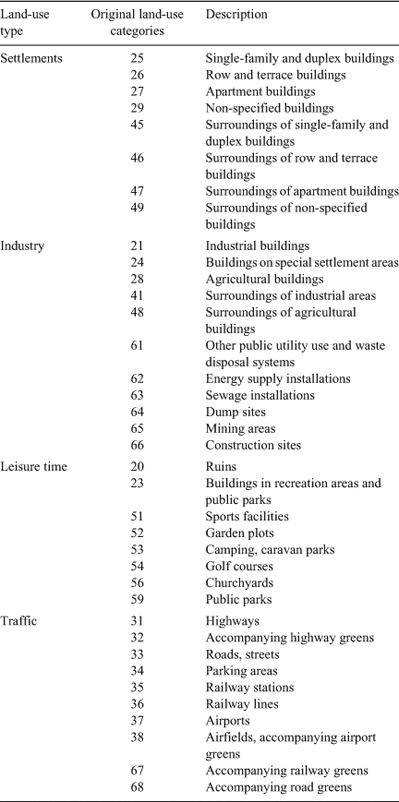Environmental determinants of lightning- v. human-induced forest fire ignitions differ in a temperate mountain region of Switzerland
Björn Reineking A B D E , Patrick Weibel A E , Marco Conedera C and Harald Bugmann A
+ Author Affiliations
- Author Affiliations
A Forest Ecology, Institute of Terrestrial Ecosystems, Department of Environmental Sciences,Swiss Federal Institute of Technology (ETH), CH-8092 Zurich, Switzerland.
B Biogeographical Modelling, BayCEER, University of Bayreuth, D-95440 Bayreuth, Germany.
C WSL Swiss Federal Research Institute, Insubric Ecosystems Group, via Belsoggiorno 22,CH-6500 Bellinzona, Switzerland.
D Corresponding author. Email: bjoern.reineking@uni-bayreuth.de
E *Authors have contributed equally to this paper.
International Journal of Wildland Fire 19(5) 541-557 https://doi.org/10.1071/WF08206
Submitted: 16 December 2008 Accepted: 9 January 2010 Published: 9 August 2010
Abstract
Understanding the environmental and human determinants of forest fire ignitions is crucial for landscape management. In this study, we consider lightning- and human-induced fires separately and evaluate the relative importance of weather, forest composition and human activities on the occurrence of forest fire ignitions in the most fire-prone region of Switzerland, the Canton Ticino. Independent variables included 14 drought and fire weather indices, forest composition and human influences. Logistic regression models were used to relate these independent variables to records of forest fires over a 37-year period (1969–2005). We found large differences in the importance of environmental and human controls on forest fire ignitions between lightning- and human-induced events: lightning-induced fires occurred in a small range of weather conditions well captured by the Duff Moisture Code from the Canadian Forest Fire Weather Index System and the LandClim Drought Index, and with negligible influence of distance to human infrastructure, whereas human-induced fires occurred in a wider range of weather conditions well captured by the Angstroem and the Fosberg Fire Weather Index, mainly in deciduous forests, and strongly depending on proximity to human infrastructure. We conclude that the suitability of fire indices can vary dramatically between ignition sources, suggesting that some of these indices are useful within certain regions and fire types only. The ignition source is an important factor that needs to be taken into account by fire managers and when developing models of forest fire occurrence.
Additional keywords: fire weather, forest composition, human influence, logistic regression, Ticino.
Acknowledgements
This study was funded by the Swiss National Science Foundation no. 3100A0–108407. Björn Reineking acknowledges additional support from the EU FP6 integrated project ALARM (GOCE-CT-2003–506675) and the ‘Bavarian Climate Program 2020’ within the joint research centre FORKAST. The authors appreciate the constructive and helpful comments from two anonymous reviewers on an earlier version of the paper.
References
Agee JK (1993) ‘Fire Ecology of Pacific Northwest Forests.’ (Island Press: Washington, DC)
Albright TP, Anderson DP, Keuler NS, Pearson SM , Turner MG
(2009) The spatial legacy of introduction: Celastrus orbiculatus in the southern Appalachians, USA. Journal of Applied Ecology 46(6), 1229–1238.
BFS (2001) ‘Waldmischungsgrad der Schweiz.’ (Bundesamt für Statistik, Sektion Raumnutzung: Neuchâte, Switzerland)
Bivand R (2009) spdep: Spatial dependence: weighting schemes, statistics and models. R-package ver. 0.4–50. Available at http://CRAN.R-project.org/package=spdep [Verified 26 July 2010]
Bjornstad ON (2009) ncf: Spatial non-parametric covariance functions. R functions for analyzing spatial (cross)-covariance. R-package ver. 1.1–3. Available at http://CRAN-R-project.org/package=ncf [Verified 26 July 2010]
Bond WJ, Woodward FI , Midgley GF
(2005) The global distribution of ecosystems in a world without fire. The New Phytologist 165(2), 525–538.
| Crossref | GoogleScholarGoogle Scholar |
CAS |
PubMed |
Botelho HS, Loureiro C, Ribeiro M, Rego F (1998) Mapping fire patterns in Trás-os-Montes region. In ‘Proceedings of the 3rd International Conference on Forest Fire Research and 14th Conference on Fire and Forest Meteorology’, 16–20 November 1998, Luso, Portugal. (Ed. DX Viegas) pp. 2693–2702. (ADAI, University of Coimbra)
Bovio G (1996) ‘Come Proteggerci dagli Incendi Boschivi.’ Collana ‘Protezione Civile e Ambiente’. (Edizioni Regione Piemonte: Torino)
Brändli UB (Ed.) (2010) ‘Schweizerisches Landesforstinventar. Ergebnisse der dritten Erhebung 2004–2006.’ (Eidgenössische Forschungsanstalt WSL: Birmensdorf, Switzerland)
Brillinger DR, Preisler HK, Benoit JW (2003) Risk assessment: a forest fire example. In ‘Science and Statistics: a Festschrift for Terry Speed’. (Ed. DR Goldstein) pp. 177–196. (Institute of Mathematical Statistics: Beachwood, OH)
Cannon SH
(2001) Debris-flow generation from recently burned watersheds. Environmental & Engineering Geoscience 7(4), 321–341.
Cesti G, Cerise A (1992) ‘Aspetti degli Incendi Boschivi. Analisi dei Comportamenti Particolari del Fuoco e delle sue Tipologie negli Incendi Boschivi. Esame di una Realtà Alpina.’ (Musumeci Editori: Quart, AO)
Conedera M, Pezzatti B (2005) Gli incendi di bosco: cosa ci dice la statistica. In ‘Dati statistiche e società’, 1-2005. pp. 6–8, 10–13. (Trimestrale dell’Ufficio di statistica del Cantone Ticino: Lugano, Switzerland)
Conedera M, Marcozzi M, Jud B, Mandallaz D, Chatelain F, Frank C, Kienast F, Ambrosetti P, Corti C (1996) ‘Incendi Boschivi al Sud delle Alpi: Passato, Presente e Possibili Sviluppi Futuri.’ (Hochschulverlag an der ETH Zürich: Zürich, Switzerland)
Conedera M, Peter L, Marxer P, Forster F, Rickenmann D , Re L
(2003) Consequences of forest fires on the hydrogeological response of mountain catchments: a case study of the Riale Buffaga, Ticino, Switzerland. Earth Surface Processes and Landforms 28(2), 117–129.
| Crossref | GoogleScholarGoogle Scholar |
Conedera M, Cesti G, Pezzatti B, Zumbrunnen T, Spinedi F (2006) Lightning-induced fires in the Alpine region: an increasing problem. In ‘V International Conference on Forest Fire Research’, 27–30 November 2006, Figueira da Foz, Portugal. (Ed. DX Viegas) (ADAI/CEIF University of Coimbra: Coimbra)
Cumming SG
(2001a) Forest type and wildfire in the Alberta boreal mixedwood: what do fires burn? Ecological Applications 11(1), 97–110.
| Crossref | GoogleScholarGoogle Scholar |
Fosberg MA (1978) Weather in wildland fire management: the fire weather index. In ‘Proceedings of the Conference on Sierra Nevada Meteorology’, 19–21 June 1978, South Lake Tahoe, USA. pp. 1–4. (American Meteorological Society: Boston, MA)
Frelich LE (2002) ‘Forest Dynamics and Disturbance Regimes: Studies from Temperate Evergreen–Deciduous Forests.’ (Cambridge University Press: Cambridge, UK)
Gerstengarbe F-W , Werner PC
(1999) Estimation of future forest fire development in the state of Brandenburg. International Forest Fire News 21, 91–93.
Harrell FE (2001) ‘Regression Modeling Strategies.’ (Springer: New York)
Harrell FE (2009) Design: design package for R. R-package ver. 2.3–0. Available at http://CRAN.R-project.org/package=Design [Verified 26 July 2010]
Hastie TJ, Tibshirani RJ (1990) ‘Generalized Additive Models.’ (Chapman & Hall: London, UK)
Hély C, Flannigan M, Bergeron Y , McRae D
(2001) Role of vegetation and weather on fire behavior in the Canadian mixedwood boreal forest using two fire behavior prediction systems. Canadian Journal of Forest Research-Revue Canadienne De Recherche Forestiere 31(3), 430–441.
| Crossref | GoogleScholarGoogle Scholar |
Hosmer DW, Lemeshow S (2000) ‘Applied Logistic Regression.’ (Wiley: New York)
Hotz M-C, Weibel F, Ringgenberg B (2005) ‘Arealstatistik Schweiz: Zahlen, Fakten, Analysen.’ (Bundesamt für Statistik: Neuchâtel, Switzerland)
Johnson EA (1992) ‘Fire and Vegetation Dynamics: Studies from the North American Boreal Forest.’ (Cambridge University Press: Cambridge, UK)
Johnson EA, Miyanashi K (2001) ‘Forest Fires: Behavior and Ecological Effects.’ (Academic Press: San Diego, CA)
Kampstra P (2008) Beanplot: a boxplot alternative for visual comparison of distributions. Journal of Statistical Software 28, 1–9. [Code Snippet 1]
Keating KA , Cherry S
(2004) Use and interpretation of logistic regression in habitat selection studies. The Journal of Wildlife Management 68(4), 774–789.
| Crossref | GoogleScholarGoogle Scholar |
Keetch JJ, Byram GM (1968) A drought index for forest fire control. USDA Forest Service, Southeastern Forest Experiment Station, Research Paper SE-38. (Asheville, NC)
Krawchuk MA, Cumming SG, Flannigan MD , Wein RW
(2006) Biotic and abiotic regulation of lightning fire initiation in the mixedwood boreal forest. Ecology 87(2), 458–468.
| Crossref | GoogleScholarGoogle Scholar |
CAS |
PubMed |
Kunkel KE (2001) Surface energy budget and fuel moisture. In ‘Forest Fires: Behaviour and Ecological Effects’. (Eds EA Johnson, K Miyanashi) pp. 303–350. (Academic Press: San Diego, CA)
Larjavaara M, Kuuluvainen T, Tanskanen H , Venalainen A
(2004) Variation in forest fire ignition probability in Finland. Silva Fennica 38(3), 253–266.
Menard S (1995) ‘Applied Logistic Regression Analysis.’ Sage University Papers on Quantitative Applications in the Social Science, Vol. 07–106. (Sage Publications: London)
Munger TT
(1916) Graphic method of representing and comparing drought intensities. Monthly Weather Review 44(11), 642–643.
| Crossref | GoogleScholarGoogle Scholar |
Nesterov VG (1949) ‘Combustibility of the Forest and Methods for its Determination.’ (USSR State Industry Press: Moscow) [In Russian]
Ott E, Frehner M, Frey H-U, Lüscher P (1997) ‘Gebirgswälder – ein praxisorientierter Leitfaden für eine standortgerechte Waldbehandlung.’ (Paul Haupt: Bern)
Patterson WA, Backman AE (1988) Fire and disease history of forests. In ‘Vegetation History’. (Eds B Huntley, T Webb) pp. 603–632. (Kluwer: Dordrecht)
Peng RD, Schoenberg FP , Woods JA
(2005) A space–time conditional intensity model for evaluating a wildfire hazard index. Journal of the American Statistical Association 100(469), 26–35.
| Crossref | GoogleScholarGoogle Scholar |
CAS |
R Development Core Team (2009) R: A language and environment for statistical computing. (R Foundation for Statistical Computing: Vienna, Austria)
Ryan KC
(2002) Dynamic interactions between forest structure and fire behavior in boreal ecosystems. Silva Fennica 36(1), 13–39.
Schüepp M, Bouet M, Bider M, Urfer C (1978) ‘Regionale Klimabeschreibungen.’ (Klimatologie der Schweiz; Beiheft zu den Annalen der Schweizerischen Meteorologischen Zentralanstalt: Zurich, Switzerland)
Schumacher S , Bugmann H
(2006) The relative importance of climatic effects, wildfires and management for future forest landscape dynamics in the Swiss Alps. Global Change Biology 12(8), 1435–1450.
| Crossref | GoogleScholarGoogle Scholar |
Skvarenina J, Mindas J, Holecy J, Tucek J (2004) Analysis of the natural and meteorological conditions during two largest forest fire events in the Slovak Paradise National Park. In ‘Proceedings of the International Scientific Workshop on Forest Fires in the Wildland–Urban Interface and Rural Areas in Europe: an integral planning and management challenge’, 15–16 May 2003, Athens, Greece. (Ed. G Xanthopoulos) pp. 29–36. (Mediterranean Agronomic Institute of Chania: Chania, Greece)
Spinedi F, Isotta F (2004) Il clima del Ticino. In ‘Dati, Statistiche e Società’, 2-2004. pp. 4–39. (Trimestrale dell’Ufficio di statistica del Cantone Ticino: Lugano, Switzerland)
Stefaní A
(1989) Boschi e incendi in Lombardia. Dendronatura 10(1), 41–47.
Stone CJ, Koo CY (1985) Additive splines in statistics. In ‘Statistical Computing Section ASA’. pp. 45–48. (American Statistical Association: Washington, DC)
Sturtevant BR, Zollner PA, Gustafson EJ , Cleland DT
(2004) Human influence on the abundance and connectivity of high-risk fuels in mixed forests of northern Wisconsin, USA. Landscape Ecology 19(3), 235–253.
| Crossref | GoogleScholarGoogle Scholar |
Thornthwaite CW, Mather JR (1957) ‘Instructions and Tables for Computing Potential Evapotranspiration and the Water Balance.’ Publications in Climatology, pp. 181–310. (Drexel Institute of Technology, Laboratory of Climatology: Centerton, NJ)
van Wagner CE (1987) Development and structure of the Canadian forest fire weather index system. Canadian Forestry Service, Forestry Technical Report 35. (Ottawa, ON)
Venevsky S, Thonicke K, Sitch S , Cramer W
(2002) Simulating fire regimes in human-dominated ecosystems: Iberian Peninsula case study. Global Change Biology 8(10), 984–998.
| Crossref | GoogleScholarGoogle Scholar |
Walsh C, Mac Nally R (2008) hier.part: Hierarchical partitioning: variance partition of a multivariate data set. R-package ver. 1.0–3. Available at http://CRAN-R-project.org/package=hier.part [Verified 26 July 2010]
Westerling AL, Hidalgo HG, Cayan DR , Swetnam TW
(2006) Warming and earlier spring increase Western US forest wildfire activity. Science 313, 940–943.
| Crossref | GoogleScholarGoogle Scholar |
CAS |
PubMed |
Zedler PH (1995) Fire frequency in southern California shrublands: biological effects and management options. In ‘Brushfires in California: Ecology and Resource Management’. (Eds JE Keeley, T Scott) pp. 101–112. (International Association of Wildland Fire: Fairfield, WA)
Zumbrunnen T, Bugmann H, Conedera M , Bürgi M
(2009) Linking forest fire regimes and climate – a historical analysis in a dry inner Alpine valley. Ecosystems 12, 73–86.
| Crossref | GoogleScholarGoogle Scholar |
and Appendix 1)

|
Appendix 3. Definition of land-use categories for distance to infrastructure
Overview on the original categories of the land-use statistics of Switzerland used for the definition of distance to infrastructure. Four sections of activities are differentiated: settlements, work, leisure time and traffic. The overall distance to infrastructure combines all four sections. The numbers in the column ‘Original land-use categories’ correspond to Hotz et al. (2005)

|




